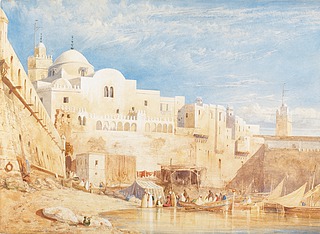Barbary States and Thorvaldsen
- Nanna Kronberg Frederiksen, arkivet.thorvaldsensmuseum.dk, 2014
- Translation by David Possen
This article presents examples of how Thorvaldsen benefited from increased Danish sea traffic in the Mediterranean due to treaties signed by Denmark with a number of North African countries during the eighteenth century.
“The Barbary States” was a general term used to refer to the Ottoman states of Morocco, Algeria, Tunisia, and Tripolitania (present-day Libya) in North Africa. The Barbary States—or “the Barbary Coast,” “the Barbaries,” “the Berber Coast,” or “Barbary,” as the region was also called—was an area notorious for sea piracy and kidnappings of the European and American sailors who plied the waters of the Mediterranean and eastern Atlantic.
Following the repeated failure of attempts to stop piracy and enslavement by force, the major European sea powers all ultimately signed treaties providing tribute payments to the Barbary States in exchange for free passage for their trading ships.
Denmark, in particular, entered into a treaty with Algeria in 1746 guaranteeing free passage for Danish ships in exchange for an annual payment in the form of gifts, money, and arms (i.e., cannons, bombs, gunpowder, and bullets). Corresponding treaties were signed between Denmark and Tripolitania in January 1753, between Denmark and Tunisia in February 1753, and between Denmark and Morocco in May 1753. As a result, each year a Danish so-called “gift ship” was sent with a “cargo of presents” to one of the Barbary States.

William Wyld, Harbor in Algiers, 1833, D656.
These agreements on the payment of tribute—or tolls, if you will—opened the Mediterranean to Danish trading companies, shipwrights, and sailors, precipitating a great upswing in trade, sea travel, and cultural exchange. One could now buy and sell one’s wares internationally, and Danish ships could take part in the growing traffic in goods between Mediterranean harbors and those in Northern and Western Europe.
Private trade and seafaring were supported by active official Danish policies, which were reflected in a large number of Danish consulates set up in harbor towns along the main routes of Danish trade. Denmark’s consuls helped to coordinate shipment traffic, and worked to ensure that communication between senders, receivers, shippers, customs officers, etc., proceeded smoothly. An example is the Danish consul in Leghorn, J. C. Ulrich, who played a crucial role over the course of three decades in facilitating the shipment of Thorvaldsen’s artworks to customers throughout Europe.
Here are a number of other concrete examples of how Thorvaldsen profited, both during his travels and at his workshop, from Denmark’s connections with these North African states:
- In 1796, Thorvaldsen sailed as a passenger on the frigate Thetis when it escorted Laurentius, the annual tribute ship, to Algeria. Thetis then proceeded to Tripoli, where the release of two Danish ships was to be negotiated with the pasha, Yusuf Karamanli (1766-1838). After its peace mission failed, Thetis sailed on to Malta, where Thorvaldsen docked and continued his journey by other means to his future home in Rome.
- In 1806, Thorvaldsen was requested to produce a monument to the United States’ victory over Tripolitania in the so-called First Barbary War, fought between 1801 and 1805. The war was fought because the Americans refused to pay tribute to avoid having their trading ships seized and their crews enslaved. Ultimately, however, it was not Thorvaldsen, but the Italian sculptor Giovanni Charles Micali, who accepted this commission.
- In 1828, many of Thorvaldsen’s artworks for the Church of Our Lady and Christiansborg Palace were transported to Copenhagen with the merchant ship Therese, which in 1827 had been in Tunisia delivering the tribute payment to Bey Al-Husayn II ibn Mahmud. The merchant ship Therese was then hired by the Building Commissions for the Church of Our Lady and Christiansborg Palace to sail back via Leghorn, in order to be loaded up there with Thorvaldsen’s crates.
- On 1.5.1833, the corvette Galathea, under the command of Johan Wilhelm Cornelius Krieger, sailed from Copenhagen toward Tangier in Morocco and Tripoli in Libya with the annual cargo of tribute “presents.” Following brief stops at Malta and Naples, Galathea docked in Leghorn, where she was loaded with artworks by Thorvaldsen intended for (inter alia) Christiansborg Palace, the Church of Our Lady, and the Academy of Fine Arts. On 20.9.1833, the ship returned to Copenhagen harbor.
- In 1843, the Danish naval officer, archaeologist, and numismatist Christian Falbe made use of the familiarity with North African coins and medals that he had gained in his time as Danish General Consul in Tunis, during the period 1820-1833, in order to produce the catalogue Cyrenaique. Falbe served as a consultant in advance of the publication of Thorvaldsen’s Collection of Coins, which includes specimens from North Africa.
References
- Documents associated with the topic Ships and Tribute to the Barbary States.
- Ole Feldbæk: Den lange fred (1700-1800), Handelsfremstød, Den Store Danske, Gyldendal.
- Ole Feldbæk: Den florissante handelsperiode, Den Store Danske, Gyldendal.
- Nanna Kronberg Frederiksen: Transportation of Thorvaldsen’s Artworks to Copenhagen, 1828, arkivet.thorvaldsensmuseum.dk, 2014.
- Peder Pavel’s diary, in: Sven Sørensen and Joseph Schirò (ed.): Malta 1796-1797, Thorvaldsen’s Visit, Malta 1996, p. 38-39 (diary of his visit to Tripoli).
- Thetis, arkivet.thorvaldsensmuseum.dk, 2009.
- Albert Thomsen: Andreas Ærebo, Den første danske konsul hos Barbareskerne, Holbæk 1946.
- C.F. Wandel: Danmark og Barbareskerne, 1746-1845, Copenhagen 1919.
Last updated 08.08.2016